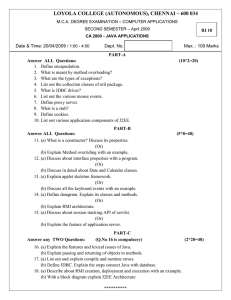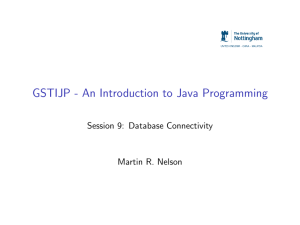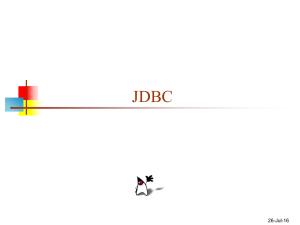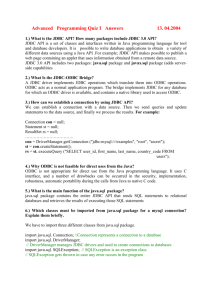JDBC 26-Jul-16
advertisement
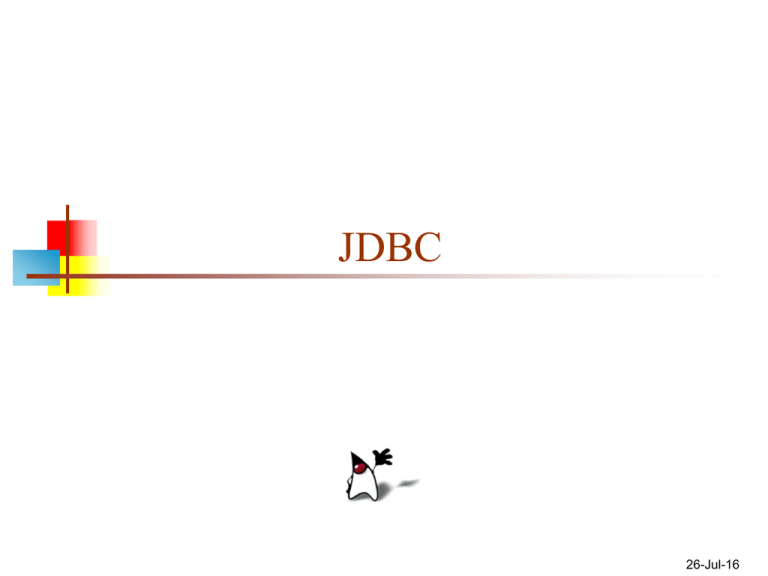
JDBC
26-Jul-16
JDBC
JDBC is a Sun trademark
It is often taken to stand for Java Database Connectivity
Java is very standardized, but there are many versions
of SQL
JDBC is a means of accessing SQL databases from Java
On the one hand, JDBC is a standardized API for use by Java
programs
On the other hand, JDBC is a specification for how third-party
vendors should write database drivers to access specific SQL
versions
Driver types
There are four types of drivers:
JDBC Type 1 Driver -- JDBC/ODBC Bridge drivers
ODBC (Open DataBase Connectivity) is a standard software API
designed to be independent of specific programming languages
Sun provides a JDBC/ODBC implementation
JDBC Type 2 Driver -- use platform-specific APIs for data
access
JDBC Type 3 Driver -- 100% Java, use a net protocol to
access a remote listener and map calls into vendor-specific
calls
JDBC Type 4 Driver -- 100% Java
Most efficient of all driver types
Connector/J
Connector/J is a JDBC Type 4 Driver for connecting
Java to MySQL
Installation is very simple:
Download the “Production Release” ZIP file from
http://dev.mysql.com/downloads/connector/j/3.1.ht
ml
Unzip it
Put the JAR file where Java can find it
Add the JAR file to your CLASSPATH, or
In Eclipse: Project --> Properties --> Java Build Path -->
Libraries --> Add External Jars...
Connecting to the server
First, make sure the MySQL server is running
In your program,
import java.sql.Connection; // not com.mysql.jdbc.Connection
import java.sql.DriverManager;
import java.sql.SQLException;
Register the JDBC driver,
Class.forName("com.mysql.jdbc.Driver").newInstance();
Invoke the getConnection() method,
Connection con =
DriverManager.getConnection("jdbc:mysql:///myDB",
myUserName,
myPassword);
or getConnection("jdbc:mysql:///myDB?user=dave&password=xxx")
A complete program
import java.sql.Connection;
import java.sql.DriverManager;
import java.sql.SQLException;
public class JdbcExample1 {
}
public static void main(String args[]) {
Connection con = null;
try {
Class.forName("com.mysql.jdbc.Driver").newInstance();
con = DriverManager.getConnection("jdbc:mysql:///test", "root", ”rootpswd");
if (!con.isClosed())
System.out.println("Successfully connected to MySQL server...");
} catch(Exception e) {
System.err.println("Exception: " + e.getMessage());
} finally {
try {
if (con != null)
con.close();
} catch(SQLException e) {}
}
}
Adapted from http://www.stardeveloper.com/articles/display.html?article=2003090401
Using the Connection object
public Statement createStatement()
throws SQLException
Creates a Statement object for sending SQL statements to the database.
SQL statements without parameters are normally executed using
Statement objects.
The Statement object may be reused for many statements
public PreparedStatement prepareStatement(String sql)
throws SQLException
Creates a PreparedStatement object for sending parameterized SQL
statements to the database.
A SQL statement with or without IN parameters can be pre-compiled
and stored in a PreparedStatement object. This object can then be
used to efficiently execute this statement multiple times.
Issuing queries
The following are methods on the Statement object:
int executeUpdate() -- for issuing queries that modify the
database and return no result set
Use for DROP TABLE, CREATE TABLE, and INSERT
Returns the number of rows in the resultant table
ResultSet executeQuery() -- for queries that do return a
result set.
Returns results as a ResultSet object
Creating a table
This example is from
http://www.kitebird.com/articles/jdbc.html
CREATE TABLE animal (
id
INT UNSIGNED NOT NULL AUTO_INCREMENT,
PRIMARY KEY (id),
name
CHAR(40),
category CHAR(40)
)
Statement s = conn.createStatement ();
s.executeUpdate ("DROP TABLE IF EXISTS animal");
s.executeUpdate (
"CREATE TABLE animal ("
+ "id INT UNSIGNED NOT NULL AUTO_INCREMENT,"
+ "PRIMARY KEY (id),“
+ "name CHAR(40), category CHAR(40))");
Populating the table
int count;
count = s.executeUpdate (
"INSERT INTO animal (name, category)"
+ " VALUES"
+ "('snake', 'reptile'),"
+ "('frog', 'amphibian'),"
+ "('tuna', 'fish'),"
+ "('racoon', 'mammal')");
s.close ();
System.out.println (count +
" rows were inserted");
ResultSet
executeQuery() returns a ResultSet
ResultSet has a very large number of getXXX methods, such
as
Results are returned from the current row
You can iterate over the rows:
public String getString(String columnName)
public String getString(int columnIndex)
public boolean next()
ResultSet objects, like Statement objects, should be
closed when you are done with them
public void close()
Example, continued
Statement s = conn.createStatement ();
s.executeQuery ("SELECT id, name, category FROM
animal");
ResultSet rs = s.getResultSet ();
int count = 0;
// Loop (next slide) goes here
rs.close ();
s.close ();
System.out.println (count + " rows were retrieved");
Example, continued
while (rs.next ()) {
int idVal = rs.getInt ("id");
String nameVal = rs.getString ("name");
String catVal = rs.getString ("category");
System.out.println (
"id = " + idVal
+ ", name = " + nameVal
+ ", category = " + catVal);
++count;
}
Prepared statements
Prepared statements are precompiled, hence much more
efficient to use
PreparedStatement s;
s = conn.prepareStatement (
"INSERT INTO animal (name, category VALUES(?,?)");
s.setString (1, nameVal);
s.setString (2, catVal);
int count = s.executeUpdate ();
s.close ();
System.out.println (count + " rows were inserted");
Error handling
try {
Statement s = conn.createStatement ();
s.executeQuery ("XYZ"); // issue invalid query
s.close ();
}
catch (SQLException e) {
System.err.println ("Error message: "
+ e.getMessage ());
System.err.println ("Error number: "
+ e.getErrorCode ());
}
The End
